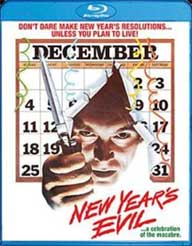 NEW
YEAR'S EVIL (1980) Blu-ray
NEW
YEAR'S EVIL (1980) Blu-rayDirector: Emmett Alston
Scream Factory/Shout! Factory
 NEW
YEAR'S EVIL (1980) Blu-ray
NEW
YEAR'S EVIL (1980) Blu-rayScream Factory rings in the New Year two months late with their Blu-ray of the Cannon slasher NEW YEAR'S EVIL!
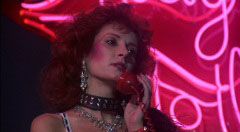
Blaze “The First Lady of Rock and Roll” aka Diane (Roz Kelly, THE OWL AND THE PUSSYCAT) – hostess of the local "Hollywood Hotline" call-in show – is hoping to compete with the major network New Year’s Eve shows with “New Year’s Evil” showcasing live performances of the New Wave bands Shadow and Made in Japan. As midnight nears on the east coast, Diane gets a call from a man identifying himself solely as "Evil" or “Eeevil” (Kip Niven, DAMNATION ALLEY) who tells her that his New Year’s resolution is to commit "MURDER… AT MID…NIGHT" and the victim will be someone close to her. Diane is aloof on the air, but demands her manager Ernie (Jed Mills, KISS DADDY GOODBYE) secure police protection since she believes that her missing assistant Yvonne (Alicia Dhanifu, producer of Jamaa Fanaka’s PENITENTIARY) – killed in the pre-credits teaser, of course – is or will be the target (it is telling that she does not show similar concern for her teenage son Derek [Grant Cramer, HARDBODIES], but he’s preoccupied with piercing his ear and wearing her red stockings over his head).
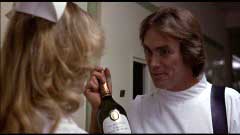 Lt.
Clayton (Chris Wallace, DON’T ANSWER THE PHONE) is skeptical at first
– given the Diane's freaky milieu – until “Evil” calls
back after midnight with a tape recording of his first killing and the location
of his victim. While “Evil” dons various disguises and prowls the
streets of Los Angeles for victims, PSYCHO coda-esque police shrink Dr. Reed
(John Alderman, PORK CHOP HILL) surmises that the mother-obsessed killer (based
on the mutilation done to the breasts of the victims) plans to commit a murder
as midnight comes around in each time zone with Diane as the final victim. Clayton
knows that they have a limited window time in which to catch the killer so he
seals off access to the show, but belligerent late arrivals provide plenty of
distraction for the on-duty cops. He urges Diane to keep him on the line as
long as possible each time he calls. The killer himself may not be able to keep
his own schedule when accidentally rouses the ire of some rough bikers while
in pursuit of another victim.
Lt.
Clayton (Chris Wallace, DON’T ANSWER THE PHONE) is skeptical at first
– given the Diane's freaky milieu – until “Evil” calls
back after midnight with a tape recording of his first killing and the location
of his victim. While “Evil” dons various disguises and prowls the
streets of Los Angeles for victims, PSYCHO coda-esque police shrink Dr. Reed
(John Alderman, PORK CHOP HILL) surmises that the mother-obsessed killer (based
on the mutilation done to the breasts of the victims) plans to commit a murder
as midnight comes around in each time zone with Diane as the final victim. Clayton
knows that they have a limited window time in which to catch the killer so he
seals off access to the show, but belligerent late arrivals provide plenty of
distraction for the on-duty cops. He urges Diane to keep him on the line as
long as possible each time he calls. The killer himself may not be able to keep
his own schedule when accidentally rouses the ire of some rough bikers while
in pursuit of another victim.
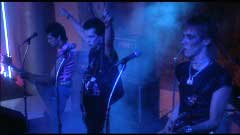
NEW YEAR’S EVIL was the first of three slashers produced by Cannon (if you don’t count the pre-Golan-Globus Cannon release SILENT NIGHT, BLOODY NIGHT and SAVAGE WEEKEND) followed by SCHIZOID with Klaus Kinski and Marianna Hill and X-RAY/HOSPITAL MASSACRE with Barbi Benton. While the dopey HOSPITAL MASSACRE had gore, some suspense, a scantily-clad Benton and an atmospheric location, NEW YEAR’S EVIL is somewhere between that and SCHIZOID with its more mature protagonists and body count. Although there are some bloody wounds, most of the killings take place offscreen, and the only nudity we get is a flasher during the opening credits. The fairly bland settings, back alleys, and L.A. streets are more suited to a crime film than a slasher. With a bit more emphasis on the investigation and less on the narcissistic heroine, this film might have sat more comfortably with some of the 1980s studio slashers-masquerading-as-mainstream-thrillers-or-action-films like TIGHTROPE and THE HERO AND THE TERROR. Deprived of the lurid money shots of the slasher genre, what we have here could play on TV fairly intact if not for some language.
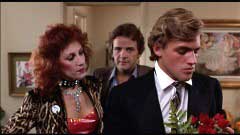 The
film probably failed to endear itself to New Wave audiences with its likening
the thrashing dancers to the drugged up inmates of the institutional setting
for one of the murder set-pieces. Nearing forty and decked out in punk make-up,
a dog collar, red stockings, and vinyl dress, the character of Diane isn’t
particularly likable – and she may completely lose viewer sympathy when
she utters the line “I’m not gonna quit, that’s what [the
killer] wants!” – and Kelly cannot reconcile the terrorized heroine
side of her character with the self-involved fame seeker that annoys us for
most of the film. It does not help that the script seems to share the killer’s
view (and that of another character) of Diane, who only shows believable vulnerability
when directly threatened by the killer during the climax. Kelly worked mainly
in television during the mid-1970s – being particularly memorable as Pinky
Tuscadero in a short stint on HAPPY DAYS – and would only make one more
movie after this: the horror comedy FULL MOON HIGH. After doing voice work on
the animated AMERICAN POP and another short string of TV guest shots, her career
ended abruptly in 1983 (and her personal life has apparently been quite troubled
since then). TV actor Niven goes all out to make this character his Scorpio
with some menacing mannerisms and quirky line readings (that are fairly unoriginal
now with so many killer characters turning to wit once they’ve been revealed
in other thrillers), while Cramer is willing to embarrass himself with a method
turn in order to make something big of his acting debut, but his suspicious
behavior is all-for-naught. Taaffe O’Connell (who got attacked by a giant
maggot in New World’s GALAXY OF TERROR the following year), Louisa Moritz
(DEATH RACE 2000), and Playboy model Teri Copley (TRANSYLVANIA TWIST) are among
the Evil’s victims (Moritz earns her death by pouring on the bubbly blonde
bimbo act and recommending the understandably tense killer try some yoga and
transcendental meditation). Jon Greene was an actual police officer who also
appeared in DON’T ANSWER THE PHONE, SCHIZOID, MANIAC COP and RELENTLESS.
The
film probably failed to endear itself to New Wave audiences with its likening
the thrashing dancers to the drugged up inmates of the institutional setting
for one of the murder set-pieces. Nearing forty and decked out in punk make-up,
a dog collar, red stockings, and vinyl dress, the character of Diane isn’t
particularly likable – and she may completely lose viewer sympathy when
she utters the line “I’m not gonna quit, that’s what [the
killer] wants!” – and Kelly cannot reconcile the terrorized heroine
side of her character with the self-involved fame seeker that annoys us for
most of the film. It does not help that the script seems to share the killer’s
view (and that of another character) of Diane, who only shows believable vulnerability
when directly threatened by the killer during the climax. Kelly worked mainly
in television during the mid-1970s – being particularly memorable as Pinky
Tuscadero in a short stint on HAPPY DAYS – and would only make one more
movie after this: the horror comedy FULL MOON HIGH. After doing voice work on
the animated AMERICAN POP and another short string of TV guest shots, her career
ended abruptly in 1983 (and her personal life has apparently been quite troubled
since then). TV actor Niven goes all out to make this character his Scorpio
with some menacing mannerisms and quirky line readings (that are fairly unoriginal
now with so many killer characters turning to wit once they’ve been revealed
in other thrillers), while Cramer is willing to embarrass himself with a method
turn in order to make something big of his acting debut, but his suspicious
behavior is all-for-naught. Taaffe O’Connell (who got attacked by a giant
maggot in New World’s GALAXY OF TERROR the following year), Louisa Moritz
(DEATH RACE 2000), and Playboy model Teri Copley (TRANSYLVANIA TWIST) are among
the Evil’s victims (Moritz earns her death by pouring on the bubbly blonde
bimbo act and recommending the understandably tense killer try some yoga and
transcendental meditation). Jon Greene was an actual police officer who also
appeared in DON’T ANSWER THE PHONE, SCHIZOID, MANIAC COP and RELENTLESS.

Director Emmett Alston started out as a cinematographer, lensing exploitation from COUNTRY BLUE to the live action footage for the adult animated feature ONCE UPON A GIRL, as well as the very obscure metaphysical horror film MOONCHILD. Alston also served as post-production supervisor on Cirio Santiago's execrable VAMPIRE HOOKERS and would make his directorial debut with THREE WAY WEEKEND. He would later helm NINE DEATHS OF THE NINJA for Crown Pictures, DEMONWARP for Vidmark, TIGERSHARK for Manson International, and the family film 3 LITTLE NINJAS AND THE LOST TREASURE would be his last film (although he also scripted the DELIVERENCE-esque HUNTER’S BLOOD). The film was the first executive producing credit for Billy Fine, who later gave us CHAINED HEAT and PENITENTIARY II (Fine was also originally hired to direct SAVAGE STREETS and JUNGLE WARRIORS but was replaced on both). Cinematographer “Edward Thomas” is actually Thomas Ackerman (BEETLEJUICE), and this was his first feature credit (although he had shot some documentaries and served as camera operator on some earlier films and TV projects). Editor Dick Brummer started out working for Russ Meyer (including editing his “Vixens” films) and would also cut SCHIZOID for Cannon. Successful disco composing/producing team W. Michael Lewis and Laurin Rinder would later score ENTER THE NINJA and REVENGE OF THE NINJA for Cannon, but their suspense music here is nothing special. Neither had anything to do with the more prominent songs including Shadow’s theme Queen-esque theme song “New Year’s Evil” or Made in Japan’s “Dumb Blondes”. A special thanks is given in the closing credits to Bill Gazzarri – dubbed “The Godfather of Rock and Roll” – whose "pay to play" nightclub Gazzarri’s on the Sunset Strip served as a launching pad for several rock acts. A soundtrack album on Cannon Records is mentioned in the closing credits but was never released (a promotional single of the theme song was distributed and can be found digitized over at YouTube).
 NEW
YEAR’S EVIL was one of a handful of Cannon titles that was released on
VHS by Paragon in the early 1980s before their distribution arrangements with
MGM and Media Home Entertainment. Cannon reissued it on VHS on their own Cannon
Video label which was distributed by Warner Home Video who had signed an agreement
to distribute Cannon’s post-1987 output on VHS under their own name).
MGM would release it on their manufactured-on-demand DVD-R Limited Edition Collection
series in a single-layer, progressive, anamorphic 1.85:1 widescreen encoding
of their HD master (also available from various streaming services like Netflix)
with only the theatrical trailer (1:45) as an extra. Whereas MGM's DVD-R presentation
started with an MGM logo before the vintage Cannon Group one, Scream Factory's
Blu-ray upgrade features a 1.78:1 1080p24 MPEG-4 AVC encoding opens with no
MGM logo and a vintage R-rating card before the Cannon logo. It’s not
a visually dazzling film, but the transfer is spotless and I’m guessing
the gel lighting and smoke in the Hollywood Hotline scenes must not have looked
too hot in the early 1980s analog video, but a degree of gloss has been restored
to Ackerman's photography here. Definition is nicely improved over the DVD in
the night exteriors while there is also better delineation between the gel lighting
and the skin tones. Bad 1980s pop music or not, it is a pity Cannon did not
spring for a Dolby Stereo mix for this one but the DTS-HD Master Audio 2.0 track
gets the job done with the original mono mix (with the music stings having more
punch than the theme song). Optional English subtitles are also included.
NEW
YEAR’S EVIL was one of a handful of Cannon titles that was released on
VHS by Paragon in the early 1980s before their distribution arrangements with
MGM and Media Home Entertainment. Cannon reissued it on VHS on their own Cannon
Video label which was distributed by Warner Home Video who had signed an agreement
to distribute Cannon’s post-1987 output on VHS under their own name).
MGM would release it on their manufactured-on-demand DVD-R Limited Edition Collection
series in a single-layer, progressive, anamorphic 1.85:1 widescreen encoding
of their HD master (also available from various streaming services like Netflix)
with only the theatrical trailer (1:45) as an extra. Whereas MGM's DVD-R presentation
started with an MGM logo before the vintage Cannon Group one, Scream Factory's
Blu-ray upgrade features a 1.78:1 1080p24 MPEG-4 AVC encoding opens with no
MGM logo and a vintage R-rating card before the Cannon logo. It’s not
a visually dazzling film, but the transfer is spotless and I’m guessing
the gel lighting and smoke in the Hollywood Hotline scenes must not have looked
too hot in the early 1980s analog video, but a degree of gloss has been restored
to Ackerman's photography here. Definition is nicely improved over the DVD in
the night exteriors while there is also better delineation between the gel lighting
and the skin tones. Bad 1980s pop music or not, it is a pity Cannon did not
spring for a Dolby Stereo mix for this one but the DTS-HD Master Audio 2.0 track
gets the job done with the original mono mix (with the music stings having more
punch than the theme song). Optional English subtitles are also included.
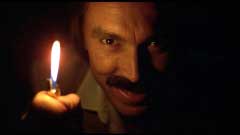
Besides carrying over the theatrical trailer from the MGM DVD-R, Scream Factory has created two new extras. Director Alston appears on a rather dry audio commentary moderated by Code Red's Bill Olsen. Alston got involved with the film through producer Billy Fine who had a script by Leonard Neubauer (Russ Meyer's BLACK SNAKE) that he was taking to Cannon (Alston reveals that he was supposed to direct ENTER THE NINJA for Cannon, but Golan took over and demoted him to second unit director while his salary stayed the same). Alston discusses the lack of a sufficient number of extras for many scenes (although the ones he got like the punks were interesting characters), other budgetary constraints (including selecting locations close to Cannon's offices), giving the actors freedom to make the most of their roles (particularly Niven and Cramer), and his feelings about the script and finished film (and also points out his cameo as a TV cameraman). Olsen gets some comments from Alston about how the actors were offscreen while also providing some background on them (Cramer did not mention his mother was actress Terry Moore when auditioning but Moore had starred in Billy Fine's HELLHOLE, and Fine later married Moritz who also appeared in Cannon's THE LAST AMERICAN VIRGIN), but things do drag for periods (which has Olsen asking questions like "How was the catering?" and twice pointing out Mills resemblance to Robert Ginty).
 Alston
is also featured in the retrospective documentary "Call Me Eeevil"
(37:16) along with cinematographer Ackerman as well as actors Niven, Cramer,
and O'Connell. Ackerman and Alston were both part of the 600th Photo Squadron
in Saigon but had been working apart in Los Angeles before the film came along.
As with Alston on the commentary, Ackerman emphasizes that the real producer
of the film was not Fine or Golan/Globus but Christopher Pearce (who would remain
with Globus at Cannon and their successor company Global Pictures after Golan
took 21st Century Film Corporation as his severance from Cannon), as well as
the challenges of the three week shoot of ten hour nights, the relaxed safety
regulations, and the all-business demeanor of Golan and Globus. Niven recalls
how the film went into production during the Screen Actors Guild strike and
the arrangements the production company had to make SAG to continue working,
and doing the killer's voice himself when the devoice meant to process his voice
provided unimpressive results. O'Connell recalls that she and Roz Kelly had
filmed a PINKY TUSCADERO pilot for Garry Marshall before the film as well as
and enjoying both her love scene and death scene with Niven. Cramer learned
about the film through an acting class acquaintance and took extraordinary measures
to make his audition memorable (bringing his own stocking and switchblade).
More a series of recollections than a making-of, the featurette – like
the commentary – is nonetheless welcome for such a minor film.
(Eric
Cotenas)
Alston
is also featured in the retrospective documentary "Call Me Eeevil"
(37:16) along with cinematographer Ackerman as well as actors Niven, Cramer,
and O'Connell. Ackerman and Alston were both part of the 600th Photo Squadron
in Saigon but had been working apart in Los Angeles before the film came along.
As with Alston on the commentary, Ackerman emphasizes that the real producer
of the film was not Fine or Golan/Globus but Christopher Pearce (who would remain
with Globus at Cannon and their successor company Global Pictures after Golan
took 21st Century Film Corporation as his severance from Cannon), as well as
the challenges of the three week shoot of ten hour nights, the relaxed safety
regulations, and the all-business demeanor of Golan and Globus. Niven recalls
how the film went into production during the Screen Actors Guild strike and
the arrangements the production company had to make SAG to continue working,
and doing the killer's voice himself when the devoice meant to process his voice
provided unimpressive results. O'Connell recalls that she and Roz Kelly had
filmed a PINKY TUSCADERO pilot for Garry Marshall before the film as well as
and enjoying both her love scene and death scene with Niven. Cramer learned
about the film through an acting class acquaintance and took extraordinary measures
to make his audition memorable (bringing his own stocking and switchblade).
More a series of recollections than a making-of, the featurette – like
the commentary – is nonetheless welcome for such a minor film.
(Eric
Cotenas)